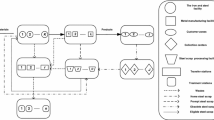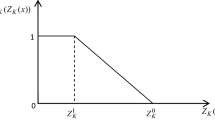Abstract
Efficient planning and design of an appropriate reverse logistics network is crucial to the economical collection and disposal of scrapped household appliances and electrical products. Such systems are commonly modelled as mixed-integer programs, whose solutions will determine the location of individual facilities that optimize material flow. One of the major drawbacks of current models is that they do not adequately address the important issue of uncertainty in demand and supply. Another deficiency in current models is that they are restricted to a two-echelon system. This study addresses these deficiencies by embodying such uncertainties in the model using the technique of fuzzy-chance constrained programming, and by extending the model to a three-echelon system. A heuristic in the form of a hybrid genetic algorithm is then employed to generate low-cost solutions. The overall objective is to find economical solutions to the general problem of determining the volume of appliances to be moved between the three echelons of customer base to collection sites, collection sites to disposal centres and disposal centre to landfill centre/remanufacturing centre; and to the problems of positioning the disposal centres and the landfill centre/remanufacturing centres within the problem domain. A case example in China is presented and the quality and robustness of the solutions are explored through sensitivity analysis.



Similar content being viewed by others
References
Caruso C, Colorni A and Paruccini M (1993). The regional urban solid waste management system: A modeling approach. Eur J Opl Res 70: 16–30.
Da QL, Huang ZQ and Zhang Q (2004). Current and future studies on structure of the reverse logistics system: A review. Chinese J Mngt Sci 12(1): 131–138 (in Chinese).
Drezner Z, Kalmroth K, Schobel A and Wesolowsky G (2002). The Weber Problem. In: Drezner Z. and Hamacher H.W. (eds). Facility Location—Application and Theory. Springer: Berlin, pp. 1–36.
Fleischmann M, Bloemhof-Ruwaard JM, Dekker R, van der Laan E, van Nunen J and van Wassenhove L (1997). Quantitative models for reverse logistics: A review. Eur J Opl Res 103: 1–17.
Fleischmann M, Krikke HR, Dekker R and Flapper SDP (2000). A characterization of logistics networks for product recovery. Omega 28: 653–666.
Gu QL and Ji JH (2005). Fuzzy chance-constrained programming model for the integrated logistics network of remanufacturing/manufacturing system. Contr Theo Appl 22: 889–894.
Jayaraman V, Guide VDR Jr, and Srivastava R (1999). A closed-loop logistics model for remanufacturing. J Opl Res Soc 50: 497–508.
Jayaraman V, Patterson RA and Rolland E (2003). The design of reverse logistics distribution networks: Models and solution procedures. Eur J Opl Res 150: 128–149.
Linton J (1999). Electronic products at their end-of-life: options and obstacles. J Elect Manuf 9(1): 29–40.
Liu BD and Iwamura K (1998). Chance constrained programming with fuzzy parameters. Fuzzy Sets Syst 94: 227–237.
Liu BD and Liu YK (2002). Expected value of fuzzy variable and fuzzy expected value models. IEEE Trans Fuzzy Syst 10: 445–450.
Liu BD and Zhao RQ (1998). Stochastic Programming and Fuzzy Programming. Tsinghua University Press: Beijing pp 164–172 (in Chinese).
Mi ZC and Rui MY (2003). A reverse logistics model of obsolescent electric household appliances. Sci Technol Prog Pol 20: 68–69 (in Chinese).
Min H, Ko HJ and Ko CS (2006). A genetic approach to developing the multi-echelon reverse logistics network for products returns. Omega 34: 56–69.
Mulder L, Scheidt LG and Schneider A (1999). Collecting electronic waste in Europe: A Sony view. In: IEEE Computer Society (ed). Proceedings of the 1999 IEEE International Symposium on Electronics and the Environment, 11–13 May, Danvers, MA, pp 244–250.
Pohlen TL and Farris II M (1992). Reverse logistics in plastics recycling. Int J Phys Distrib Logist Mngt 22(7): 35–47.
Yu J and Bai S (2002). How to manage obsolescent household appliance? Synth Util Chinese Res 6: 26–27 (in Chinese).
Zadeh LA (1965). Fuzzy sets. Inform Control 8: 338–353.
Zadeh LA (1978). Fuzzy sets as a basis for a theory of possibility. Fuzzy Sets Syst 1: 3–28.
Zadeh LA (1979). A theory of approximate reasoning. In: Hayes J., Michie D. and Thrall R.M. (eds). Mathematical Frontiers of the Social and Policy Sciences. Westview Press: Boulder, CO, pp. 69–129.
Zhao ZW and Tang WS (2006). Application of the analytic hierarchy process based on fuzzy simulation in the evaluation of venture investment projects. Fuzzy Syst Math 20(4): 128–133.
Author information
Authors and Affiliations
Rights and permissions
About this article
Cite this article
Chu, L., Shi, Y., Lin, S. et al. Fuzzy chance-constrained programming model for a multi-echelon reverse logistics network for household appliances. J Oper Res Soc 61, 551–560 (2010). https://doi.org/10.1057/jors.2008.162
Received:
Accepted:
Published:
Issue Date:
DOI: https://doi.org/10.1057/jors.2008.162




